If you are a long-term reader of WASD or a loyal full-chain gamer, you may have heard of Loot Survivor, a Rougelike developed by Bibliotheca DAO on Starknet Survival game.
What you may not know, however, is that this is just the tip of the iceberg, as the game and the entities behind it are cogs in a much larger machine: Realms.World .
Realms not only represent isolated full-chain games, but also represent an interconnected ecosystem across Starknet and its L3 (L3 integrated with L2) .
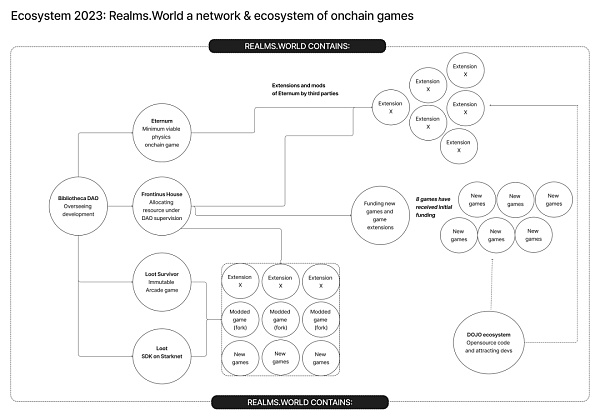
It's an ambitious vision, and today we'll start to understand it, with this ultimate guide divided into two parts.
In the first part of this article, we will discuss:
The second part will focus more on degen, we will explore:
History
Realms was launched in August 2021 as a spin-off of the text-based NFT series Loot.
The first version of the project is the eponymous Realms NFT series, a set of 8,000 (one per Loot NFT) digital realms, each The minting price is 0.03 ETH.
Originally, these NFTs were used in an on-chain strategy game for Ethereum L1 called Realms: Eternum.
However, due to issues such as high data storage costs, long synchronization times, and the difficulty of maintaining custom indexers, Bibliotheca DAO (the DAO that manages the development of the Realms ecosystem) decided Moving to building Eternum on Starknet.
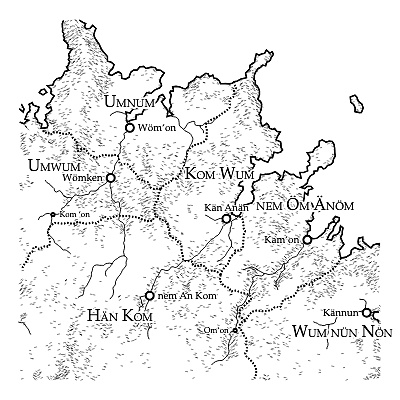
In the bear market that followed its launch, Realms proved that it was more than just a Loot derivative by establishing itself as a full-chain gaming project.
In addition to the second game "Eternum", the aforementioned "Loot Survivor" was also released on the test network in July 2023 and launched in November 2023. It was deployed to the Starknet mainnet in a pre-release form at the beginning of the month.
Bibliotheca DAO also contributed to the development of Dojo, which further promoted the broader development of full-chain gaming on Starknet.
Dojo is an "engine" or framework based on which it is easier to build the entire chain using the Cairo language (the language used for Starknet smart contract programming) Go to the game.
Finally, they made a major move to expand the Realms ecosystem to third parties beyond their two own games.
This includes the launch of Frontius House in September 2023 and the subsequent allocation of $1,000,000 $LORDS to 10 projects in the ecosystem through the Genesis Grants program (more on this later) introduce).
Organization
Now that we know the history of Realms For context, let's take a look at the two main entities in the Realms ecosystem.
Bibliotheca DAO
You can view Bibliotheca DAO as as the “Ethereum Foundation for Realms” as they are the entity responsible for developing its two own games (the aforementioned Loot Survivor and Eternum) and help set the strategic direction of the ecosystem.
The DAO is governed by the $LORDS token, the native token of Realms, which we will take a closer look at in Part 2.
Currently, Bibliotheca DAO uses Snapshot for off-chain governance.
However,The DAO plans to move the governance process entirely on-chain and implement a voting escrow system where $LORDS holders will be able to stake their tokens , to gain the right to participate in governanceand directly inject liquidity into different asset liquidity pools in the ecosystem.
Frontius House
A recent rise in Realms The secondary organization is Frontius House.
Frontius House is governed by the Bibliotheca DAO, the $LORDS holder.
It is responsible for helping to expand the scope of projects beyond Loot Survivor and Eternum by allocating DAO resources to third-party projects looking to build in the ecosystem.
This includes games, infrastructure, educational resources, etc.
As mentioned previously, to kick off the process, Frontius House held a first round of Genesis grants to be distributed to 10 projects selected through community voting 1,000,000 LORDS (approximately $90,000).
The items are:
Arcane Assembler: A spell-making game using play-2-die mechanics.
Loot Royale: A PVP battle royale game created by BladeDAO.
Rising Revenant: An exploration game where players build outposts and try to win the jackpot.
Risk of the Realms: an on-chain adaptation of the board game Risk, set in the Realms universe , and built using Dojo.
Call The Banners: A social game where players can team up, attack, and hunt for treasure.
Crypts and Caverns: A generative on-chain map of Lootverse NFTs.
Kist: This project aims to create a framework for building hackers in the Realms ecosystem Marathon project.
Loot Herald: A media division that produces content about the Realms ecosystem.
Instaswap: AMM for swapping ERC-1155 tokens on Starknet.
Loot Survivor
Now that we understand the history and organization of Realms, let's look at the first ecosystem-owned game: Loot Survivor.
Overview:
Loot Survivor is a Rogue Like In the game, your goal (as the name suggests) is to survive in a post-apocalyptic world for as long as possible.
To do this, you need to take on the role of an adventurer and venture into the so-called "mist".
When you enter the "fog", you either emerge unscathed or encounter monsters.
Not surprisingly, monsters are the real bane of your existence, as they want to defeat, kill you and eliminate you from the game.
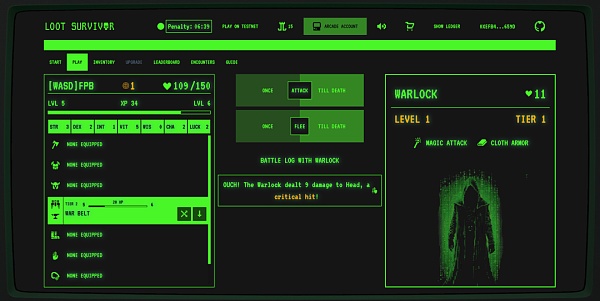
There are 75 different types of monsters, and when facing one of them, you will have two choices:
Try to run away and possibly avoid getting hurt
Fight and risk losing health or dying
Fight p>
If you choose option 2 and kill the monster, you will receive XP and gold coins.
Both can help extend your survival, as the game allows you to upgrade one of six adventurer attributes (pictured below) and purchase them individually Items or potions.
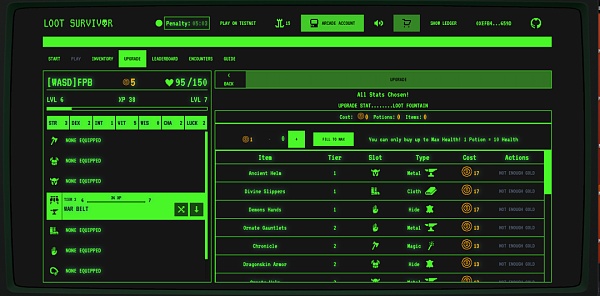
Background:
Loot Survivor is currently playable on testnet and mainnet, although the latter is the game's " "Pre-release" or limited version.
The game is free on the testnet, but to play a game of Loot Survivor on the mainnet, you must pay 25 $LORDS, which is approximately $LORDS at the current price $14.50.
A portion of these $LORDS tokens will be redistributed as rewards to the top 3 players on the game leaderboard (i.e. the players who have survived the longest and scored the highest points) .
This mechanism is called "Play-To-Die" (P2D).
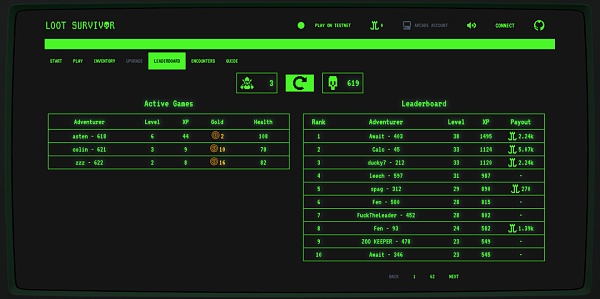
Despite its short release on mainnet, Loot Survivor has already garnered huge attention with over 100 hours of gameplay.
This game contract also ranks in the top 5 in terms of gas consumption on all Starknet.
Initial impression:
Overall, I I really like Loot Survivor and think its gameplay is fun.
I really like the strategy aspect of this game because there are so many different ways to build your adventurer.
For example, you can get very aggressive by trying to hire every monster you see.
Alternatively, you take the opposite approach and try to escape every time you encounter a monster.
However, as with many times in life, the best approach may be to strike a balance between the two.
You can also allocate experience points and gold coins in a variety of ways to execute your game plan, such as optimizing brute force by increasing strength, or improving charisma. Prioritize mobility.
I think this strategic depth helps make the game more interesting and increases its replay value, as each game is related to the previous one different.
I also really like the art style of the game, as I like the monster designs, color schemes, and scores.
Furthermore,Loot Survivor’s user experience has improved significantly in the months since implementing Arcade Accounts, which supports signature-free disposable wallets Improvement.
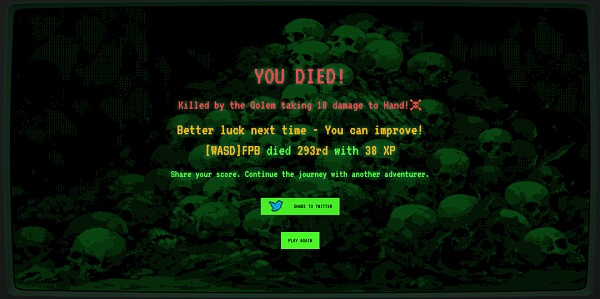
Despite this, I don't think Loot Survivor is a finished product and there is room for improvement in both gameplay and user experience.
First of all, I think the encounters could be more engaging.
Now, when encountering a monster, you can only choose the "attack" or "escape" option, and then wait for the transaction to be confirmed to see the results.
I would love to see the team add some animations or graphics to make this wait more suspenseful and visually exciting.
My biggest complaint about the user experience is the wait time.
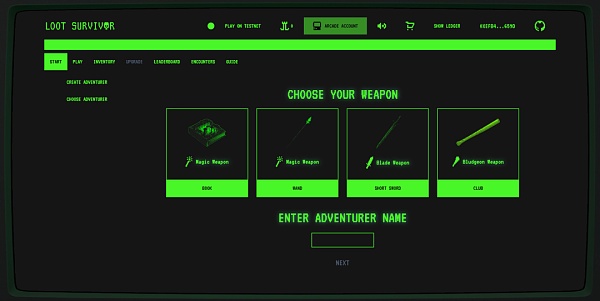
You must wait for a certain number of block confirmations before playing the Loot Survivor game on mainnet.
Although this is done to prevent bots, I found it frustrating as I had to wait over 6 minutes for it to start.
Also, there is a latency penalty if you wait too long between entering the fog (around 6-7 minutes).
While I understand the original intention of reducing bot attacks, I think the current approach is equally frustrating because you can basically only complete one in one session Game (may take 30 minutes or more).
Review: History, Vision and Entity of Realms
< img src="https://img.jinse.cn/7178314_image3.png">
Let’s briefly review the first part.
Realms launched in August 2021 with the release of a collection of Loot-inspired NFTs of the same name (more on that later).
Since then, the ecosystem has continued to grow under the stewardship of Bibliotheca DAO, a decentralized gaming studio and research laboratory.
DAO focuses on developing "Realms World", an autonomous world composed of an interconnected full-chain game network.
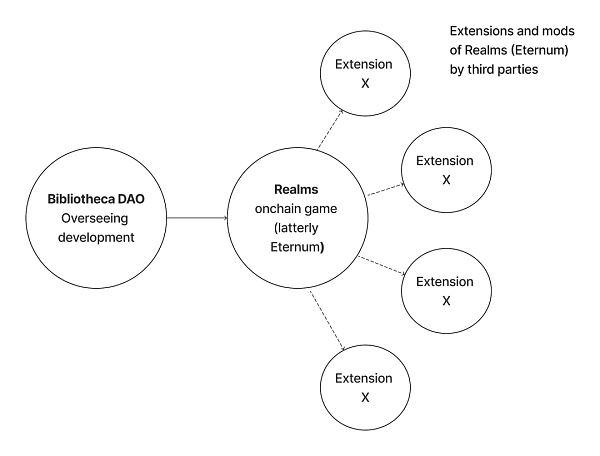
Originally, the Realms ecosystem consisted solely of Bibliotheca DAO and Eternum (formerly Realms: Eternum).
Since then, the ecosystem has grown rapidly as the project's ambitions have grown.
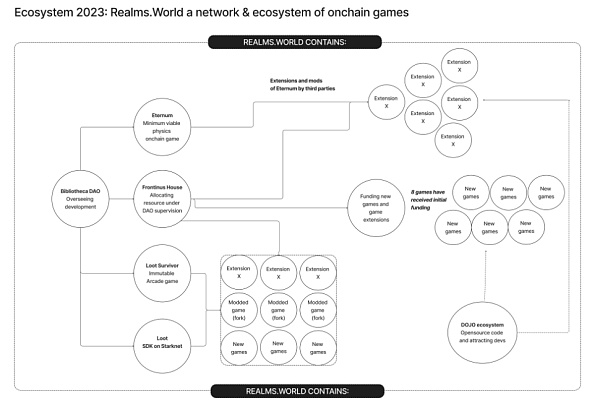
Today, Realms consists not only of Bibliotheca DAO and Eternum, but also:
< strong>Loot Survivor: A Rogue Like survival game that can be experienced on the Starknet mainnet.
Frontius House: An entity that provides funding and resources for other projects built in the Realms.
Dojo: A full-chain game framework built on Starknet using Cairo, Bibliotheca DAO is the One of the contributors to the framework.
Many other projects are being built within the Realms ecosystem, including:
Arcane Assembler: A spell-making game using play-2-die mechanics.
Loot Royale: A PVP battle royale game created by BladeDAO.
Loot Underworld: A dungeon crawler for Realms, developed in partnership with Endless Crawler and funDAOmental.
0xMississippi: A PVP Rogue Like game.
Rising Revenant: An exploration game where players build outposts and try to win the jackpot.
Loot Autochess: (as the name suggests) an automatic battle game similar to chess.
Risk of the Realms: an on-chain adaptation of the board game Risk, set in the Realms universe , and built using Dojo.
Call The Banners: A social game where players can team up, attack, and find treasure.
Crypts and Caverns: A generative on-chain map of Lootverse NFTs.
Eternum
Now that we understand the Realms ecosystem, let's delve into Eternum.
Eternum is a strategy game built using Dojo.
It combines elements of empire management and conquest, and players must collect resources, build armies, and fight to expand territory.
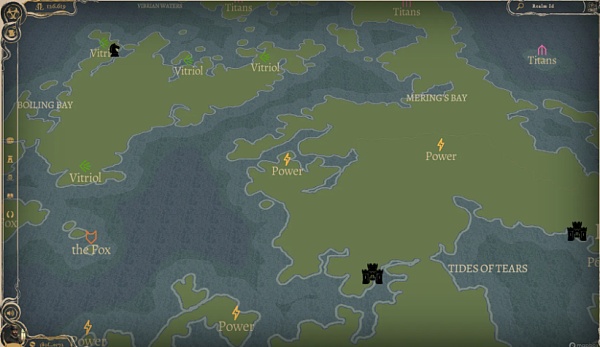
To play Eternum, you need to own Realms NFT (more on that later).
I generally dislike this model as it sets a high barrier to entry (its floor price is 0.55 ETH as of this writing).
I hope the community will create extensions to make it more accessible.
Eternum is not yet live, but has been alpha tested on Starkent Katana L3 in the past to check its economic system.
Under the hood, while the game will run on Starknet, game data will be recorded on Ethereum to enhance decentralization and immutability.
Bibliotheca DAO has chosen to build its unique features on the network, such as Cairo, STARKS, and chain-native account abstractions to help improve the user experience.
Another interesting thing about Eternum is its philosophy and goal of building an "eternal game," Bibliotheca DAO stated in its recent black paper This is explained.
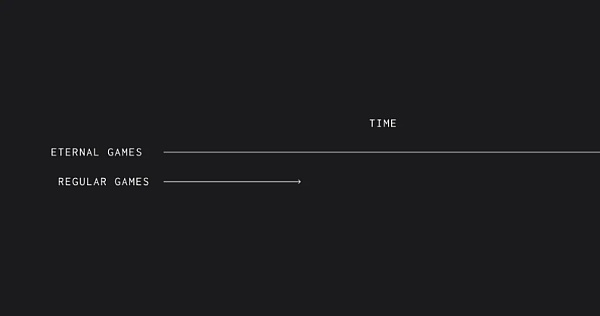
In this spirit, some of the design principles used by Eternum to help achieve this include:
While players will set goals, Eternum will not Has a definite endpoint and is designed to continue indefinitely.
Eternum's governance is performed by Realms holders, aligning incentives and ensuring that Eternum is not controlled by any single entity.
Eternum’s logic and state are stored on-chain, providing transparency and immutability.
Overall, despite my concerns about the barrier to entry, I can’t wait to see Eternum go live on mainnet and these principles come into practice.
Realms Assets
Now we know about Eternum , giving us a deeper look at the assets that power it and the broader Realms ecosystem.
Realms NFT
Realms are 8,000 on the Ethereum mainnet Collection of NFTs.
Each Realms has its own map describing its regions, cities, rivers, and terrain, as well as different resource reserves.
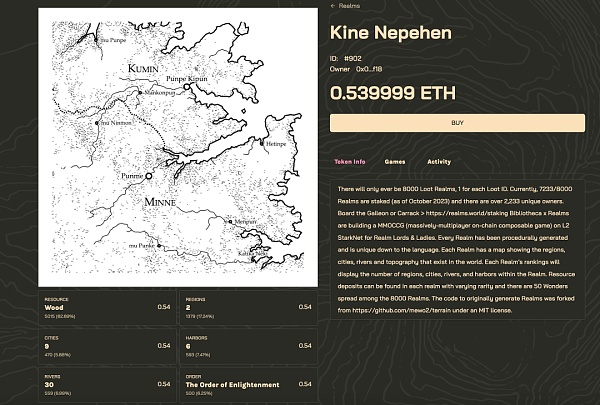
Realms NFT plays a key role in the ecosystem and is used for:
Realms NFTs can also be staked to earn $LORDS rewards .
These can be earned at a rate of 43.75 or 49 per week, depending on how you claim your rewards.
One of the interesting things about this series is their potential use in other Realms games.
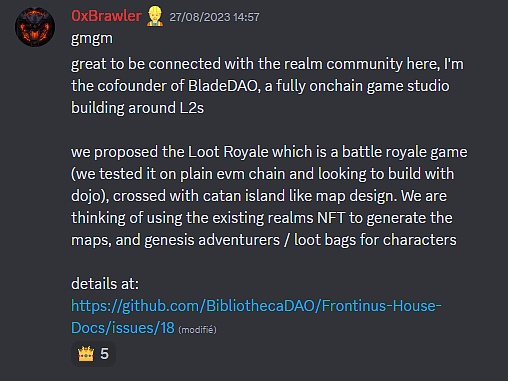
For example, BladeDAO may want to integrate NFTs by using them to generate maps and items in its game Loot Royale, according to messages in the Realms Discord server.
LORDS
$LORDS is a utility for the Realms ecosystem Token.
Today, in addition to being distributed as rewards for Realms stakers, the token is mainly used in Loot Survivor.
Loot Survivor features an "on-chain arcade" mode where players must deposit 25 $LORDS ($14.50) to play a round.
A portion of these tokens are then redistributed to the highest-scoring players in the game via a Play-to-Die (P2D) mechanism.
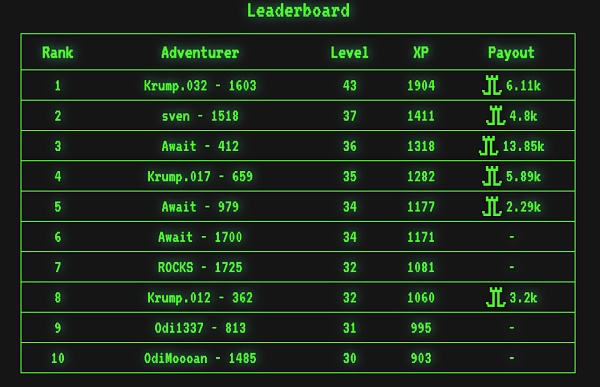
However, according to the black paper, $LORDS may undergo a major transformation with the launch of the Realms protocol.
If these proposed changes are implemented, holders will be able to lock their $LORDS tokens into veLORDS, giving them the ability to allocate their token release directly to Rights to different liquidity pools throughout the ecosystem.
In addition, the proposed design will be powered by a new token, dLORDS, which can be burned in exchange for $LORDS.
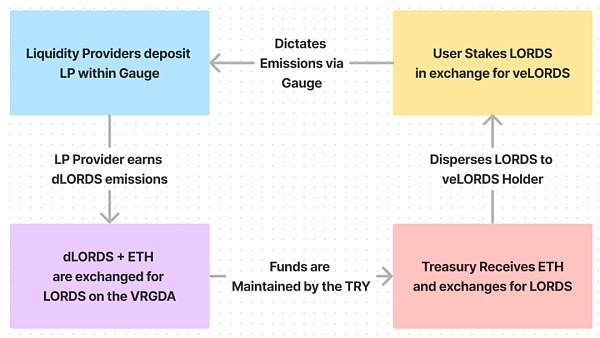
As you may have seen on X, $LORDS has been on a tear lately, up 580% since December 1st.
In my opinion, in addition to the general interest in Starknet, this increase is due to the token liquidity owned by the DAO migrating from the Ethereum mainnet to Starknet itself Ekubo DEX.
Other NFT series
There are currently other NFT series in the Realms ecosystem There are two other NFT collections.
They are:
Beasts
< p style="text-align:center">
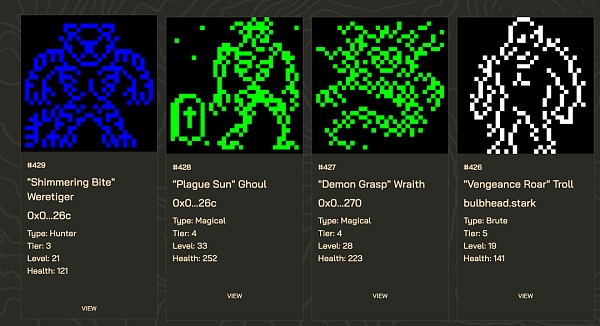
If you're the first player to encounter a new beast in Loot Survivor, you can mint an on-chain art collectible.
Golden Tokens

An NFT series that provides holders with one NFT every 24 hours A free game of Loot Survivor.
Optimistic about Realms
Overall, I am optimistic about Realms The future of Realms.
For me, this project represents a unique experiment in the AW space, because it allows teams to build within an interconnected game ecosystem, and Players can have a say in how they are managed.
Despite the considerable cost of doing so, I'd like to be able to play Eternum, and am at least curious to see how it performs upon release.
Also, I am eager to see how Realms NFT and LORDS tokens are used as the ecosystem continues to grow.
The biggest reason I am optimistic about the future of this project is its community.
Games on the entire chain require a strong community composed of developers, players, testers, etc.
Realms certainly has that, with a very active Discord and of course numerous projects and people building on it.
I'm excited to see what they continue to create in the coming months.
 Wilfred
Wilfred

























